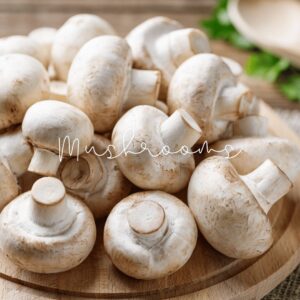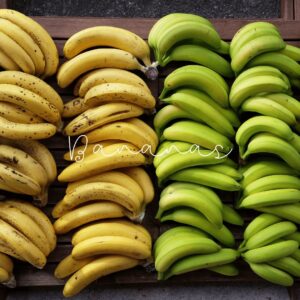When it comes to eye health, colorful fruits and vegetables often take center stage. But did you know that white foods can also play a crucial role in protecting and improving your vision?
In this guide, we’ll explore six incredible white foods that are packed with nutrients essential for maintaining healthy eyes. Whether you’re looking to boost your vision or add more variety to your diet, these white wonders are worth considering.
Can White Foods Improve Eye Health?
Yes! White foods like garlic, mushrooms, and potatoes are rich in antioxidants, vitamins, and minerals that support eye health. These nutrients can help protect against oxidative stress, prevent degenerative eye conditions, and promote overall vision wellness.
Let’s dive into the top six white foods for healthier eyes!
6. Cauliflower: How Does Cauliflower Benefit Eye Health?
Cauliflower, a member of the cruciferous vegetable family, is loaded with vitamin C, a powerful antioxidant that protects eye cells from oxidative stress.
How to Use: Roast, mash, or rice cauliflower for a versatile addition to your meals.
Why It Helps:
Guards against free radicals that contribute to cataracts and age-related macular degeneration (AMD).
Provides vitamin K, folate, and fiber, which support overall health and vision.
Evidence: Studies in the American Journal of Clinical Nutrition link high vitamin C intake to a reduced risk of cataracts.

Cauliflower, a member of the cruciferous vegetable family that often goes unnoticed next to its greener relatives.
But don’t let its pale color fool you—cauliflower is a powerhouse when it comes to nutrients, especially vitamin C, which plays a crucial role in eye health.
Vitamin C is a potent antioxidant that the body relies on to protect against oxidative stress.
In the eyes, this means guarding the cells from damage caused by free radicals, unstable molecules that can harm cells and contribute to chronic diseases, including cataracts and age-related macular degeneration.
By incorporating cauliflower into your diet, you are directly supplying your eyes with the defenses they need to combat these harmful particles.
Interestingly, a study published in the American Journal of Clinical Nutrition found that higher intakes of vitamin C were associated with a lower risk of cataracts.
This makes cauliflower, which can provide approximately 77% of the recommended daily vitamin C intake in just one cup, an excellent food choice for those looking to protect their eyesight.
But cauliflower’s benefits don’t stop at vitamin C. It also offers a good supply of vitamin K, folate, and fiber, making it a well-rounded vegetable that supports overall health, which in turn can help maintain healthy vision.
Its versatility in recipes—from roasted florets and cauliflower steaks to mashed cauliflower or rice—means you can easily incorporate it into meals without feeling like you’re eating the same dish over and over.
5. Garlic: Is Garlic Good for Your Eyes?
Garlic, a kitchen staple, is rich in sulfur, selenium, and vitamin C, all of which are essential for eye health.
How to Use: Add garlic to sauces, soups, or roasted vegetables for flavor and eye health benefits.
Why It Helps:
Boosts glutathione production, an antioxidant that protects the lens from oxidative damage.
Reduces the risk of cataracts and AMD.
Evidence: Studies in the Journal of Nutrition highlight the role of garlic in preventing cataract formation.

Garlic, a staple ingredient in cuisines worldwide, renowned not just for its ability to elevate the flavors of a dish but also for its impressive health benefits, particularly for the eyes.
Garlic is rich in sulfur, a critical element in the production of glutathione, which is a powerful antioxidant essential for protecting the eyes.
Glutathione plays a pivotal role in maintaining the health of the eye’s lens and helps prevent oxidative damage that can lead to cataracts.
Cataracts occur when the lens of the eye becomes cloudy, impairing vision, and are commonly associated with aging.
The antioxidants provided by glutathione help maintain the clarity and health of the lens, actively combating the formation of cataracts.
Garlic is also a source of selenium and vitamin C, both of which are known to support eye health. Selenium works in conjunction with vitamin E (also found in garlic) to protect the eyes from free radical damage, while vitamin C can reduce the risk of cataract formation and promote the health of ocular blood vessels.
Research, including studies published in journals such as the Journal of Nutrition, supports the role of these nutrients in reducing the progression of age-related macular degeneration and cataract formation.
This positions garlic as a powerful food for maintaining eye health and preventing common eye diseases.
4. Mushrooms: Can Mushrooms Protect Against Vision Loss?
Mushrooms are a great source of selenium, an essential mineral that supports antioxidant defenses in the eyes.
How to Use: Incorporate mushrooms into soups, stir-fries, or salads for a delicious and nutritious boost.
Why It Helps:
Prevents oxidative stress that leads to AMD and cataracts.
Supports the health of the retina and lens.
Evidence: Research in the British Journal of Nutrition links selenium intake to a reduced risk of AMD.

Mushrooms, a versatile and nutritious addition to any diet, and a true ally for eye health.
Mushrooms aren’t just delicious; they’re also a significant source of selenium, a mineral that plays a key role in the body’s antioxidant defense system.
Selenium is crucial for the production of antioxidant enzymes, including glutathione peroxidase, which is particularly important for protecting the eyes.
These enzymes help combat oxidative stress, a condition caused by an excess of harmful free radicals in the body.
Oxidative stress is a major contributor to several eye conditions, including age-related macular degeneration (AMD) and cataract formation, both of which are leading causes of vision impairment and blindness in older adults.
By neutralizing free radicals, the antioxidants supported by selenium can prevent or slow the oxidative damage to the macula (the central part of the retina) and the lens of the eye.
This protective action helps maintain clear vision and overall eye health.
Studies published in the “British Journal of Nutrition,” has indicated that higher dietary intakes of selenium are associated with a lower risk of advanced age-related macular degeneration, underscoring the importance of this mineral in maintaining eye health.
Mushrooms can be added to soups, salads, stir-fries, and even as a meat substitute in burgers and stews due to their rich, umami flavor.
So, when planning your meals, consider mushrooms a go-to ingredient for both their taste and eye health benefits.
3. Onions: Do Onions Help Prevent Cataracts?
Onions are rich in quercetin, a flavonoid antioxidant that protects against oxidative stress.
How to Use: Sauté onions as a base for soups and stews or add them raw to salads for a burst of flavor and nutrients.
Why It Helps:
Reduces the risk of cataracts by protecting the lens from free radical damage.
Offers anti-inflammatory benefits that promote overall eye health.
Evidence: Studies in the Journal of Nutrition highlight quercetin’s role in reducing the risk of chronic eye diseases.

Onions, a common kitchen staple known for their distinct flavor and numerous health benefits, especially for eye health.
Onions are particularly rich in quercetin, a flavonoid that serves as a powerful antioxidant.
Quercetin is highly effective in combating oxidative stress, a key factor in eye health deterioration.
This antioxidant specifically helps protect the lens of the eye from oxidative damage, which can lead to cataracts.
Studies, such as those published in the “Journal of Nutrition,” have highlighted the role of antioxidants like quercetin in reducing the risk of chronic eye diseases and promoting visual health.
Cataracts develop when proteins in the lens of the eye clump together, clouding the lens and leading to decreased vision and, if untreated, blindness.
By neutralizing free radicals, quercetin helps maintain the clarity and functionality of the lens, significantly reducing the risk of cataract formation.
Additionally, quercetin has anti-inflammatory properties that can benefit overall eye health.
Chronic inflammation can contribute to various eye diseases, including macular degeneration, so managing inflammation is crucial for maintaining good vision.
Onions not only add depth and flavor to dishes, but they also provide significant health benefits, making them a valuable component of a diet aimed at maintaining or improving eye health.
2. Bananas: Can Bananas Prevent Eye Conditions?
Bananas are a rich source of potassium, which helps maintain proper fluid balance and regulate eye pressure.
How to Use: Enjoy bananas as a snack, blend them into smoothies, or add them to oatmeal. For those managing blood sugar, opt for less ripe bananas with a lower glycemic index.
Why It Helps:
Prevents elevated intraocular pressure, reducing the risk of glaucoma.
Promotes overall eye health by stabilizing fluid levels.

Bananas, a beloved fruit known for their creamy texture and comforting taste.
But beyond their appeal as a snack, bananas are incredibly beneficial for eye health, primarily due to their high potassium content.
Potassium is a vital mineral that plays a crucial role in maintaining fluid balance throughout the body, including within the eyes.
Proper fluid balance is essential for maintaining correct eye pressure.
Elevated eye pressure, or intraocular pressure, can lead to glaucoma, a group of eye conditions that cause damage to the optic nerve, which is vital for good vision.
This damage is often linked to abnormally high pressure inside the eye.
By helping to regulate this pressure, potassium can play a significant part in preventing glaucoma and other similar eye conditions.
Regular consumption of bananas ensures a steady supply of potassium, aiding in the prevention of vision impairment and loss due to pressure-related eye conditions.
This makes bananas not only a tasty addition to your diet but also a strategic one for maintaining eye health.
However, it’s important to note that bananas are high in natural sugars, especially as they ripen.
For individuals managing diabetes or those concerned about blood sugar levels, choosing less ripe bananas can be a better option.
The greener, less ripe bananas have a lower glycemic index, meaning they have less impact on blood sugar levels compared to their fully ripe counterparts.
As bananas ripen, the starch in the fruit converts to sugar, increasing the fruit’s sugar content. Therefore, if you are monitoring your sugar intake, opt for bananas that are firmer and less sweet.
1. Potatoes: How Do Potatoes Promote Eye Health?
Potatoes, particularly white potatoes, are packed with vitamin C and beta-carotene, both essential for vision.
How to Use: Bake, boil, or mash potatoes for a comforting and nutritious meal. Avoid frying to maximize their health benefits.
Why It Helps:
Beta-carotene converts to vitamin A, which supports night vision and prevents conditions like night blindness.
Vitamin C protects against oxidative stress, reducing the risk of cataracts and AMD.

These humble tubers are often underestimated in discussions about health foods, but they are truly nutritional powerhouses, especially beneficial for eye health.
Potatoes, particularly white potatoes, are rich in vitamin C and beta-carotene, two vital nutrients for maintaining good vision.
Beta-carotene is a type of carotenoid that the body converts into vitamin A, a crucial nutrient for maintaining healthy vision.
Vitamin A is essential for forming rhodopsin, a protein in the eyes that allows you to see in low light conditions.
Without sufficient vitamin A, people can suffer from night blindness, making it difficult to see in the dark or in dimly lit environments.
Therefore, including beta-carotene-rich foods like potatoes in your diet helps ensure your body gets enough of this essential nutrient to support good night vision.
In addition to beta-carotene, potatoes also offer a good dose of vitamin C.
This antioxidant is known for its role in boosting the immune system, but it also plays a critical role in eye health.
Vitamin C helps protect the eyes against oxidative stress, which can lead to degenerative eye diseases such as cataracts and age-related macular degeneration.
Potatoes are incredibly versatile and can be enjoyed in numerous ways, making them easy to incorporate into your daily meals.
Whether baked, boiled, mashed, or roasted, they can be a delicious part of your diet. Just be mindful of how they are prepared—opting for baking or boiling rather than frying to maximize their health benefits.
How to Incorporate These White Foods into Your Diet
- Plan Balanced Meals: Combine white foods with colorful vegetables for a nutrient-rich plate.
- Experiment with Recipes: Try roasting garlic, mashing cauliflower, or making a hearty mushroom stew.
- Mind Preparation Methods: Opt for steaming, baking, or boiling over frying to preserve nutrients.
White Foods for Eye Health
These 6 white foods—cauliflower, garlic, mushrooms, onions, bananas, and potatoes—are packed with nutrients that can protect and enhance your vision. By including them in your diet, you can take a proactive step toward maintaining healthy eyes and preventing common vision problems.
What’s Your Favorite Eye-Healthy Food?
Have you tried incorporating any of these white foods into your meals? Share your favorite recipes or tips in the comments below—we’d love to hear how you keep your eyes healthy and bright!
Eat well, see better, and stay healthy!